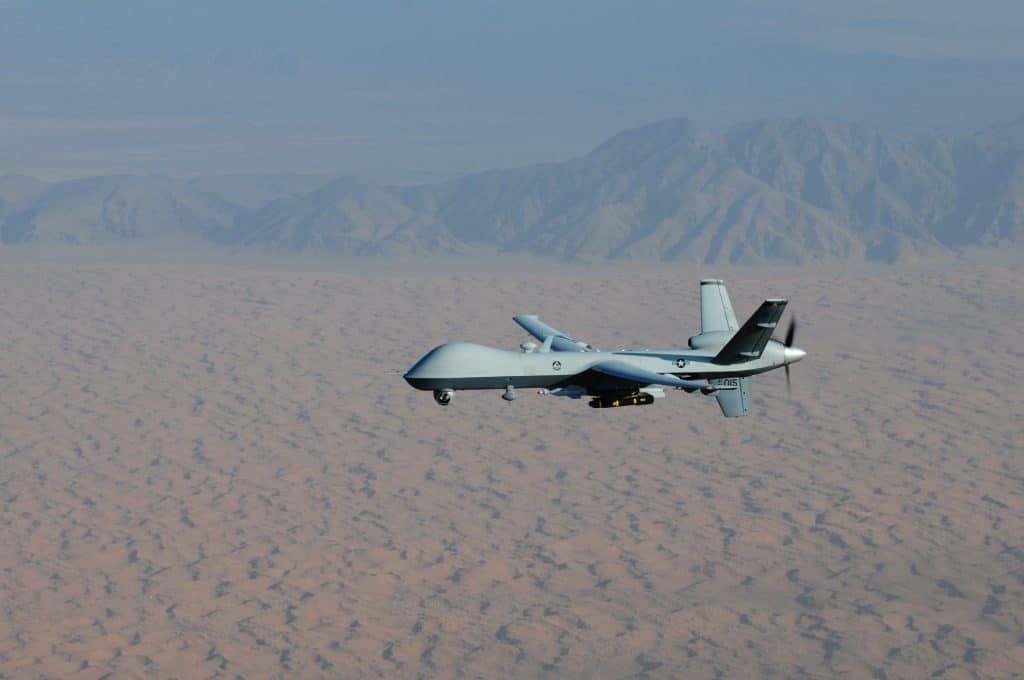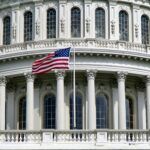We need a new international accord to control drone proliferation
By Agnes Callamard, James Rogers | December 1, 2020
 An MQ-9 Reaper unmanned aerial vehicle, armed with laser-guided munitions and Hellfire missiles, flies a combat mission over southern Afghanistan. Credit: Lt. Col. Leslie Pratt/US Air Force
An MQ-9 Reaper unmanned aerial vehicle, armed with laser-guided munitions and Hellfire missiles, flies a combat mission over southern Afghanistan. Credit: Lt. Col. Leslie Pratt/US Air Force
The Caucasus descended into “drone vs. drone” warfare over the summer, when Armenia and Azerbaijan fought for command of the air above the contested territory of Nagorno-Karabakh, an ethnic Armenian enclave located within the legal boundaries of Azerbaijan. Both sides in this conflict had military drones, which are readily available through Turkish or Israeli export to Azerbaijan and local supply to Armenian forces.
In Libya, a similar scene has emerged as Turkey has deployed its Bayraktar TB2 military drone in support of the UN-recognized Government of National Accord, in a proxy war against the UAE and Saudi Arabia, which are operating Chinese Wing Loong II drones in support of Field Marshal Khalifa Haftar of the so-called Libyan National Army.
Conflicts like these, in which high-tech armed drones help decide the fate of nations, are becoming increasingly common. Equally concerning is the increasing use of drones for targeted killings in purported self-defense, such as the assassination of Iranian General Qasem Soleimani and others by the United States in Iraq in January. The proliferation and evolution of drone technology puts such killings within the reach of multiple state and non-state actors, who may kill anonymously and with impunity.
Put simply, the world has entered a second drone age, in which new “Drone Powers” use remotely operated military technologies as the spearhead of state power, at the cost of thousands of lives. The burgeoning international market for drones, which comes with its own “drone diplomacy,” drives this trend.
The Missile Technology Control Regime, or MTCR—a 1980s control mechanism intended to prevent the spread of unmanned systems that can deliver weapons of mass destruction—has not stopped the proliferation of armed drones, and the Trump administration’s decision to re-interpret the MTCR has only made things worse. Instead, nation states must work together to establish a new regime for the new drone age, and President-elect Biden should consider supporting such a move. Call it a Drone Technology Control Regime.
A second drone age. In her latest report, the UN Special Rapporteur on Extrajudicial, Summary, or Arbitrary Executions (this article’s co-author, Agnes Callamard) argued that the world has entered a “second drone age.” It is marked by the uncontrolled proliferation of armed drones, the most advanced of which are stealthier, speedier, smaller, and more capable of targeted killings than a previous generation.
As of March 2020, at least 102 nations had acquired military drones, and around 40 possessed, or were in the process of purchasing, armed drones. Some 35 states are now believed to own drones in the largest and deadliest class of these weapons, and at least 20 non-state actors have acquired weaponized drone technologies. Since 2015, the United States and at least 10 other countries (Egypt, Israel, Iraq, Iran, Nigeria, Pakistan, Saudi Arabia, Turkey, the United Kingdom, and the UAE) have allegedly operated drones for the use of force, such as in targeted killings. This drone proliferation has started to have a marked impact on international security.
Drone developments inevitably affect the lives of civilians. For instance, more than 80 percent of the total number of civilian deaths in Yemen from 2009 to 2014 were caused by drones, according to research conducted by the nonprofit research and analysis organization CNA. Far more casualties are attributed to drone strikes than are officially acknowledged or reported. The Pentagon’s estimate for how many civilians it killed in Syria, as defense technology journalist Kelsey D. Atherton has reported, differ by “between a factor of 20 and a factor of 50” from independent assessors like Airwars or The Bureau of Investigative Journalism.
The harm caused by armed drone strikes extends beyond killings. Many more civilians are wounded, or experience daily terror under the constant anticipation of a drone attack.
New age requires a new control regime. It is in this new, evolved drone context that we must ask: How do we even begin to control the concerning, and increasingly visible, manifestations of the second drone age? The Missile Technology Control Regime (MTCR) is not the appropriate mechanism. It is a product of the Cold War that was set up “to coordinate national export licensing efforts aimed at preventing proliferation of unmanned delivery systems capable of delivering weapons of mass destruction.”
The MTCR has limited the US sale of large military drones—like Predator, Reaper, and Global Hawk—because the US interpretation of MTCR guidance had thus far included certain military drones in Category I of the MTCR, which concerns the sale and transfer of systems that can deliver weapons of mass destruction. However, this has not prevented China or other nations not party to the regime from selling similar military drones at will and with little regulation.
China is one of the world’s top three suppliers of military drones: As of September 2019, the Center for the Study of the Drone reports that 32 countries operate at least one drone made in China, including Egypt, which operates 60 such drones; Saudi Arabia, which has 70; and the UAE, which owns 40. Drone sales are reportedly part of China’s attempt to develop and consolidate diplomatic relationships with recipient states, a “drone diplomacy” particularly pursued in the context of China’s global economic Belt and Road Initiative.
The Trump administration has approved changes to the US interpretation of the Missile Technology Control Regime guidelines, a decision that probably reflects the US determination to maintain a leadership position in the drone arms race.
In a statement last year, Assistant Secretary of State for International Security and Nonproliferation Christopher Ford argued that recent advances in drone technologies have led to an increase in the use of weapons systems that may technically fall within the MTCR restrictions, but do not “present the type of nuclear weapon delivery threat that the MTCR was established in order to help forestall.” Put simply, the reinterpretation allows for US “bestsellers” like the Predator, Reaper, Global Hawk to be sold more easily.
As indicated by the Trump administration’s advance notice to Congress last month, the first use of this reinterpretation is likely to facilitate the sale of Reaper drones to Taiwan. The UAE is also on the list of nations set to benefit from the reinterpretation, as the government attempts to squeeze in the sale of 18 MQ-9B Reaper drones before Trump leaves office on January 20, 2021. As the US government seeks to counter Chinese influence, such sales are seen as vital to re-establishing US dominance in these lucrative and politically important markets. The White House has adopted this position despite well-evidenced war crimes in Yemen by the Saudi-UAE coalition, which are fueled by arms transfers from the United States and other actors. Such arms transfers themselves likely amount to complicity in the multiple crimes against the Yemeni population.
While it is clear that the MTCR, designed to regulate missile technology, does not effectively regulate the global sale of drones, the US approach misses the bigger picture and is likely to exacerbate the problem of drone proliferation globally and in the longer term. Instead, nation states must work together to negotiate a Drone Technology Control Regime.
One of the problems with the MTCR is that it only includes a few nations. As drones become cheaper and more readily available, a Drone Technology Control Regime, or DTCR, must seek a broader consensus. It should include the recent recommendations made in the Special Rapporteur’s report; by UNIDIR, the UN’s institute for disarmament research; and by many civil society organizations.
Specifically, in order to control the “free for all” that is emerging in the second drone age, states must establish a transparent, multilateral process to develop robust standards for the design, export, and use of drones. They should enact stricter controls on the transfer of military and dual-use drone technologies, and apply clear criteria to prevent irresponsible transfers. Any drone sales agreement must include civilian protection and adherence to international human rights and humanitarian law. States must work together to adopt a dedicated process of operational end-use monitoring to report transparently on the outcome of drone strikes and their impact on civilians and so-called “targets.”
As drones spread globally to all nations, or indeed to any non-state actors that want them, the foundational pillars of accountability, transparency, and oversight are needed to strengthen the protection of civilians.
The mere existence of a technology does not justify its indiscriminate and irresponsible deployment and transfer. The expanding technological prowess and the proliferation of drones are a major threat to international peace and security. At a time of increasingly dangerous instability in the international system, the time to act is now.
Together, we make the world safer.
The Bulletin elevates expert voices above the noise. But as an independent nonprofit organization, our operations depend on the support of readers like you. Help us continue to deliver quality journalism that holds leaders accountable. Your support of our work at any level is important. In return, we promise our coverage will be understandable, influential, vigilant, solution-oriented, and fair-minded. Together we can make a difference.
Keywords: Missile Technology Control Regime, drones
Topics: Disruptive Technologies, Opinion
















